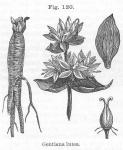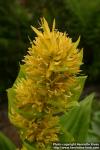
 Preparations: Compound Tincture of Gentian
- Compound Infusion of Gentian
- Extract of Gentian
- Fluid Extract of Gentian
- Compound Fluid Extract of Gentian
Preparations: Compound Tincture of Gentian
- Compound Infusion of Gentian
- Extract of Gentian
- Fluid Extract of Gentian
- Compound Fluid Extract of Gentian
Related entries: Ochroleucous Gentian
- Five-Flowered Gentian
"The root of Gentiana lutea, Linné."—(U. S. P).
Nat. Ord.—Gentianeae.
COMMON NAMES: Gentian, Gentian-root.
ILLUSTRATION: Bentley and Trimen, Med. Plants, 182.
Botanical Source.—This plant has a long, thick, cylindrical, wrinkled, ringed, forked, perennial root, brown externally, and yellow within. The stem is 3 or 4 feet high, hollow, stout, and erect. The radical leaves are ovate-oblong, 5-nerved, and 2 or 3 inches broad; those on the stem sessile, ovate, and acute; those next the flowers cordate, amplexicaul, and concave; all are a pale, bright-green. The flowers are large, bright-yellow, in many-flowered whorls, and peduncled; the calyx is monophyllous, of a papery texture, semitransparent, 3 or 4-cleft, with short, lanceolate, unequal segments. The corolla is rotate, with a very short tube, 5 or 6 green glands at the base, A or 6-parted, with oblong, acute, narrow, veiny lobes; the Stamens, 5 or 6 in number, are not so long as the corolla; the anthers are subulate, somewhat united, becoming distinct; the ovary conical; the stigmas sessile and revolute; the capsule stalked, oblong, 2-valved, and 1-celled, and the seeds are many and flattened, with thin, brownish edges (L.).
History and Description.—This plant is common to the central and southern parts of Europe, especially the Pyrenees, Alps, etc., being found from 3,000 to 5,000 feet above the level of the sea. Its root affords the medicinal portion, and is brought to this market from Havre, Marseilles, etc. The U. S. P. describes it as follows:
"In nearly cylindrical pieces or longitudinal slices, about 25 Mm. (1 inch) thick, the upper portion closely annulate, the lower portion longitudinally wrinkled; externally deep yellowish-brown; internally lighter; somewhat flexible and tough when damp; rather brittle when dry; fracture uneven; the bark rather thick; separated from the somewhat spongy meditullium by a black cambium line; odor peculiar, faint, more prominent when moistened; taste sweetish and persistently bitter"—(U. S. P).
The root imparts its virtues readily to cold or hot water, alcohol, or sulphuric ether. A liquor prepared from it in some parts of Switzerland is much prized as a stomachic; it is made by macerating the root in cold water, adding some sugar, yeast, and distilling after vinous fermentation has occurred. Flückiger (Pharmacognosie, 1891), states that as a consequence of this use, the plant has almost disappeared from some parts of Switzerland.
Chemical Composition.—The following three proximate principles are the characteristic constituents of gentian root: Gentiopikrin, of Kromayer (1862), to which the root owes its bitterness; gentisin, of Hlasiwetz and Habermann (1875), a yellow, tasteless substance, whose reactions with ferric chloride seem to have been mistaken for those of tannin (see Maisch, Amer. Jour. Pharm., 1876, p. 486, and 1880, p. 1); and gentianose, of Arthur Meyer (1882), a crystallizable, fermentable sugar, not reducing Fehling's solution, and which occurs in the fresh root only. The root also contains a volatile oil to which its odor is due; fatty and resinous matter, uncrystallizable sugar, large quantities of mucilage, about 8 per cent of ash, but no starch. Drying the root seems to have the effect of increasing the resinous matter (Flückiger, Pharmacognosie, 1891).
GENTIOPIKRIN (C20H30O12), first obtained pure by Kromayer (Arch. der Pharm., 1862, Vol. CLX, p. 27), was previously described as gentianin by Henry and Caventou (1821), and later differentiated by Trommsdorff, Leconte, and Dulk into the bitter gentianin and the non-bitter acid gentisin or gentisic acid.
Gentiopikrin is completely abstracted from aqueous solution by animal charcoal; on this principle its purification was affected. It crystallizes in needles of bitter taste, soluble in water and alcohol, insoluble in pure ether. It is a glucosid, being decomposed by diluted acids into sugar and amorphous, yellow-brown, bitter gentiogenin (C14H16O5.. Kromayer obtained from 6 pounds of fresh root only 4 grammes of crystallized gentiopikrin. Ɣ Flückinger (1891) records that alcoholic tinctures of gentian root lose their bitterness upon standing, crystallized dextrose being deposited (Crawfurd and Wittstein). Alkali likewise destroys the bitterness of the tincture.
GENTISIN (C14H10O5., of Hlasiwetz and Habermann (Jahresb. der Pharm., 1874, p. 309), forms yellow, tasteless needles, nearly insoluble in water and ether, crystallizable from alcohol. The researches of Kostanecki and his pupils (Ber. d. Deutsch. Chem. Ges. Ref., 1891 and 1894) have shown that this substance is a trioxyxanthone belonging to the same class of substances as chrysin, quercetin, fisetin, and other vegetable dyes. Fusing with caustic potash splits gentisin into acetic acid, phloroglucin, and oxysalicylic acid (C9H6O4), an isomer of protocatechuic acid, it was probably the gentisic or gentianic acid of older authors. In 1894, Kostanecki and Tambor succeeded in effecting the complete chemical synthesis of gentisin (which is methyl-gentiseïn, Kostanecki, 1891); gentiseïn (C13H8O5.+ H2O) being the intermediary product (Ber. d, Deutsch. Chem. Ges. Ref., 1894, p. 190). G.W. Kennedy (Amer. Jour. Pharm., 1881, p. 280), found gentiopikrin and gentisin also in the root of Frasera Walteri (which see).
Action, Medical Uses, and Dosage.—A powerful tonic, improves the appetite, strengthens digestion, gives more force to the circulation, and slightly elevates the heat of the body. When taken in large doses it is apt to oppress the stomach, irritate the bowels, and even produces nausea and vomiting, as well as fullness of pulse and headache. Its administration is contraindicated where gastric irritability or inflammation are present. Used in cases of debility and exhaustion, and in all cases where a tonic is required, as dyspepsia, gout, amenorrhoea, hysteria, scrofula, intermittents, diarrhoea, worms, etc. A tincture made by percolation of 1 part of podophyllum and 5 parts of gentian, diluted alcohol being the menstruum, was prized by Prof. Scudder as one of the most efficient remedies for "atony of the stomach and bowels with feeble or slow digestion" (Spec. Med.). Gentian is valuable to relieve irritation and increase the appetite, after protracted fevers, where the powers of life are depressed and recovery depends upon ability to assimilate food. Dose of the powder, from 10 to 30 grains; of the extract, from 1 to 10 grains; of infusion, 1 or 2 fluid ounces; of tincture, 1 or 2 fluid drachms; of specific gentiana, 5 to 40 drops.
Dr. Küchenmeister believes that impure and uncrystallized gentianin (see previous editions of the Amer. Disp.) is the most valuable substitute for quinine, acting as rapidly and as efficaciously on the spleen, in doses of from 15 to 30 grains twice a day.
Specific Indications and Uses.—"Sense of depression referred to epigastric region, and associated with sense of physical and mental weariness" (Scudder, List of Specific Indications).
Related Species.—Gentiana Catesbaei, Walter (Gentiana Saponaria, Linné). Blue or American gentian, has a perennial, branching, somewhat fleshy root, with a simple, erect, rough stem, 8 to 10 inches in height. Leaves opposite, ovate or lanceolate, slightly 3-veined, acute, rough on the margin. Flowers large, blue, crowded, subsessile, axillary, and terminal. Calyx divided into 4 or 5 linear-lanceolate segments longer than the tube. Corolla large, blue, ventricose, plaited; its border divided into 10 segments, the outer 5 roundish and more or less acute, the inner 5 bifid and imbricate. Stamens 5, with dilated filaments and sagittate anthers. Ovary oblong-lanceolate, compressed, supported by a sort of pedicel. Style none; stigmas 2, oblong, reflexed. Capsule oblong, acuminate, 1-celled, 2-valved (L.—B.). It grows in the grassy swamps and meadows of North and South Carolina, flowering from September to December. The root is about 1/3 inch in thickness and 3 inches long, having a vivid, yellow, epidermal covering, under which is a whitish, spongy, cortical layer enclosing a thin column of woody tissue. Its bitterness is less pronounced than that of the official drug. It is little inferior to the foreign gentian, and way be used as a substitute for it in all cases, in the same doses and preparations. Alcohol and boiling water extract its virtues. Probably the Gentiana Andrewsii, Grisebach, or Closed blue gentian, the Gentiana puberula, Michaux, and the Gentiana crinita, Froelich, or Blue fringed gentian possess analogous medicinal virtues. Maisch believed the two first-mentioned to be collected indiscriminately with the Gentiana Catesbaei, of Walter. The same author also found the root of Gentiana crinita, Froelich, and of G. Catesbaei, Walter, to be free from tannin (Amer. Jour. Pharm., 1876, p. 487).
The following European species are sometimes gathered and used like gentian:
Gentiana purpurea, Linné. South and Central Europe, in Alpine meadows. Differs from gentian root only in having a peculiarly branched top, and being of a more pronounced bitter. Flowers yellow-purple.
Gentiana punctata, Linné. South and Central Europe, Alpine districts. Resembles preceding. Flowers yellow and dotted with purple.
Gentiana pannonica, Scopoli. Austrian mountain districts. Root smaller than that of G. purpurea, but similar in other respects. Flowers deep-purple.

